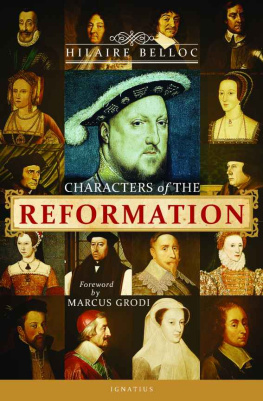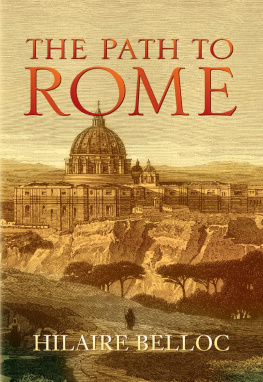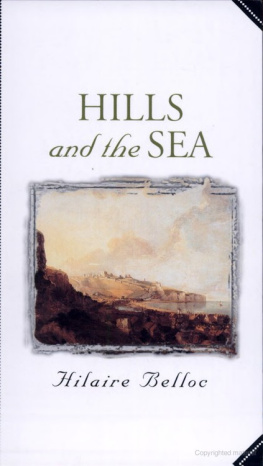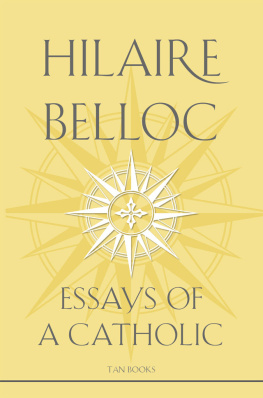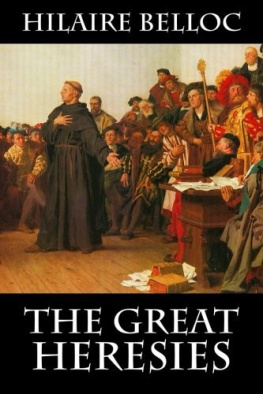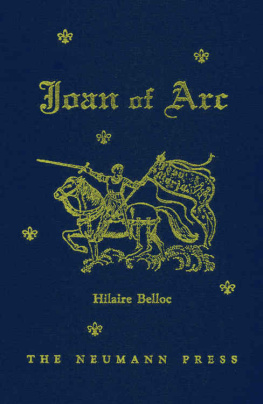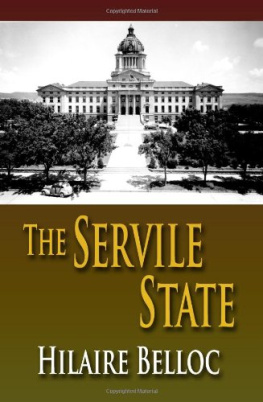CHARACTERS OF THE
REFORMATION
HILAIRE BELLOC
CHARACTERS
OF THE
REFORMATION
With a Foreword by Marcus Grodi
IGNATIUS PRESS SAN FRANCISCO
Original copyright 1936 by Hilaire Belloc
First published by Sheed and Ward, London, 1936
Cover image montage:
First row (left to right): Henry IV of France, Louis XIV,
Ren Descartes, Oliver Cromwell
Second row: Catherine of Aragon, Henry VIII, Anne Boleyn
Third row: Thomas More, Thomas Cromwell
Fourth row: Mary Tudor, Thomas Cranmer, Gustavus Adolphus, Elizabeth I
Fifth row: Ferdinand II, Cardinal Richelieu, Mary Stuart, Blaise Pascal
Wickimedia Commons images
Cover design by Enrique Javier Aguilar Pinto
Belloc text reprinted in 2017 by Ignatius Press, San Francisco
Foreword 2017 by Ignatius Press, San Francisco
All rights reserved
ISBN 978-1-62164-137-7 (PB)
ISBN 978-1-68149-762-4 (EB)
Library of Congress Control Number 2016939763
Printed in the United States of America
CONTENTS
FOREWORD
Some books have aspects that are both timeless and timely. Such is this selection of biographical sketches by Hilaire Belloc. This is particularly so as we approach the five hundredth anniversary of the beginning of the Protestant Reformation, but also because of the debilitating trajectory of our present modern culture.
Hilaire Belloc was a prolific English writer and communicator during the first half of the twentieth century. He was an undaunted defender of the Catholic faith. His friendship and witness were the key factors that led another prolific writer into the Church: G. K. Chesterton. They became a teamsometimes coined the Chesterbellocwhom many have considered the most effective lay apologists of the Catholic faith. More often we hear praise of Chesterton, due to his creative and entertaining turn of phrase, but for many, the straightforward wit and no holds barred clarity of Belloc is far more appealing and readable. Admittedly, this was my personal preference, for the many writings of Belloc played an important part in my own conversion to the Catholic faith.
When I tell the story of my conversion, I include a story about shoestrings. I was a young, newly ordained pastor when a woman in my congregation pulled me aside to tell me something urgent and important. She whispered with great concern, You dont tie your shoestrings correctly! Your loops lie front to back instead of side to side! I had no idea that there were alternative ways to tie shoes, let alone that it was something to be so concerned about. But I looked down, and sure enough, my strings lay front to back! I shifted the loops into place, but one shake of my shoes and they were back misaligned. As a result I forced myself to relearn tying my shoes, and now, forty years later, I still have to think through carefully every time to make sure the loops lie correctly!
I relate this admittedly ridiculous story because it nevertheless illustrates an important lessonwhich I believe relates to the importance of this book by Hilaire Belloc: we are generally not open to a solution until we know there is a problem. Until that woman bravely confronted me, I had no motive to reconsider and then relearn tying my shoes, which I had been tying wrong since childhood. Until I read this book, and books like it, I had no idea I needed to rethink the problem of the Reformation.
As a young Protestant pastor, I was aware of the confusion and the divisions within Christianity and saw the need for renewal at the local and worldwide levelbut I did not really see the problem. I saw nothing wrong with Protestantism per se or with key Protestant doctrines like sola scriptura, sola fide or once saved, always saved. I assumed that the causes of confusion and division were in me and other Christians who were blinded by and divided by our sinfulness. But once I was awakened to the true problem, I was also by grace open to the true answer. This is what Bellocs book helped me to discover. By giving a more accurate glimpse into the key people who started, guided, and, in some cases, kidnapped the Reformation, leading to the problem of the revolt, Belloc helped me see the true solution, both to the renewal that was needed long before the Reformation and also to the renewal that is still needed todayfor much of what Belloc addressed is still equally true.
Far too many people, all their lives, have lived with misconceptions about the Reformation and see no reason to think otherwise. They may see the divisions among the myriad of churches in their community or around the world but have no motivation to do anything about it. I believe that hearing the stories of those who played instrumental roles in the divisions caused by the Reformation can open us up to a better understanding of why these divisions occurred and how the unity that our Lord prayed for can be reestablished.
With the coming five hundredth anniversary of Luthers nailing of his Ninety-Five Theses on the Wittenberg church door, it is significant to remember that this was but the most public spark that led to the Reformation wildfire. For many years, churchmen had been calling for and working toward the necessary renewal of the Church. However, the key problems that opened the door for Luthers initial call for a scholarly dialogue, which evolved into a many-headed rebellion against the established Church, were the years of poor catechesis and formation of the masses. Far too many Christians by the turn of the sixteenth century were sadly ignorant of the basics of the Faith. Belloc states, There were grave corruptions in the Church and grave discontent with the organization of the Church on the part of masses of men who never dreamed of destroying Church unity or interfering with the great mass of Church doctrine and custom (19-20). The average Catholic knew and could practice almost effortlessly the external rituals and devotions of the Church, but what he lacked was an internal sincere surrender to Christa life-changing internal faith. It was primarily this that Father Luther addressed; as Belloc states, During the first twenty years or so, from 1517 onwards, the revolt against the Church was closely intermixed with a very legitimate determination to reform abuses (19). The end result, however, was an overreaction, leading to a de-emphasis of all things external and an overemphasis upon faith alone . As Belloc states:
The breakup of united western Christendom with the coming of the Reformation was by far the most important thing in history since the foundation of the Catholic Church fifteen hundred years before.Men of foresight perceived at the time that if the catastrophe were allowed to consummate itself, if the revolt were to be successful (and it was successful), our civilization would certainly be imperilled and possibly, in the long run, destroyed. (17)
This is why this book is so important to read, for as Belloc insists:
That indeed is what has happened. Europe with all her culture is now seriously imperilled and stands no small chance of being destroyed by her own internal disruption; and all this is ultimately the fruit of the great religious revolution which began four hundred years ago.That being so, the Reformation being of this importance, it ought to form the chief object of historical study in modern times, and its nature should be clearly understood even if only in outline. (17)
Belloc made this claim nearly eighty years ago. He had no idea the extent to which what he was seeing then would bring us to today. Belloc continued, The early enthusiasm for change was anarchic and dispersed. It had no form. It was of a violence which was bound to burn itself out, especially as it was resisted by all the organized central authorities of Christendom: the Kings and the Emperor. All that descended directly from the ancient foundation of our culture, the Romanized, civilized core of Europe, held outsave for one province: Britain (22).
Next page
